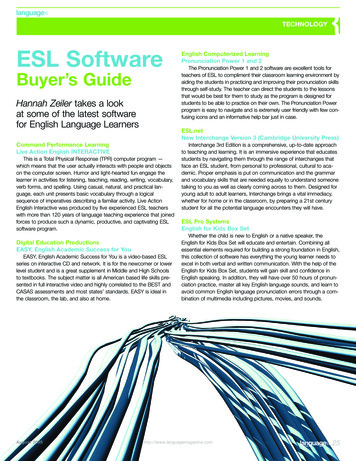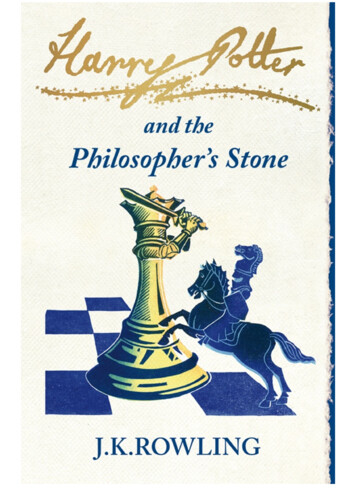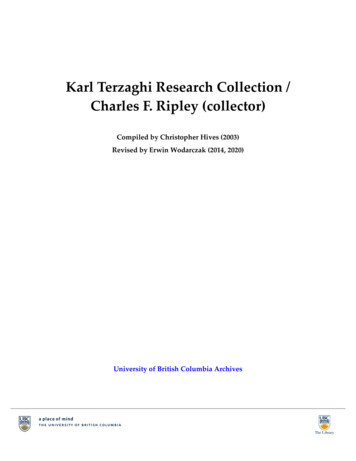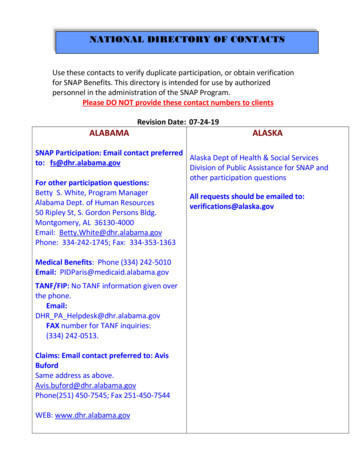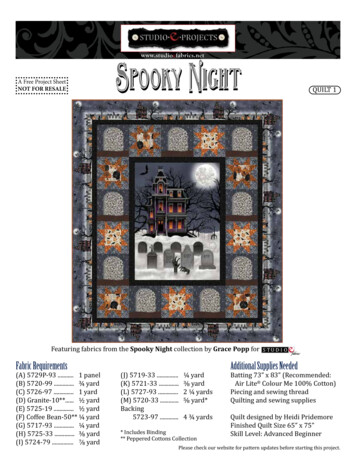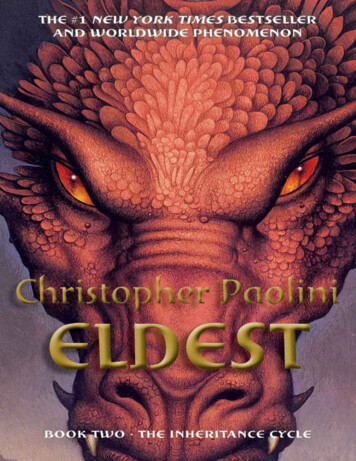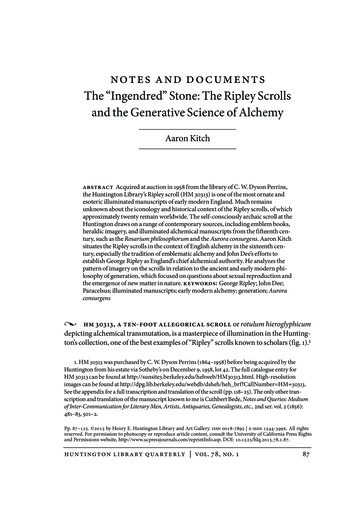
Transcription
notes and d o cumentsThe “Ingendred” Stone: The Ripley Scrollsand the Generative Science of AlchemyAaron Kitchabstract Acquired at auction in 1958 from the library of C. W. Dyson Perrins,the Huntington Library’s Ripley scroll (HM 30313) is one of the most ornate andesoteric illuminated manuscripts of early modern England. Much remainsunknown about the iconology and historical context of the Ripley scrolls, of whichapproximately twenty remain worldwide. The self-consciously archaic scroll at theHuntington draws on a range of contemporary sources, including emblem books,heraldic imagery, and illuminated alchemical manuscripts from the fifteenth century, such as the Rosarium philosophorum and the Aurora consurgens. Aaron Kitchsituates the Ripley scrolls in the context of English alchemy in the sixteenth century, especially the tradition of emblematic alchemy and John Dee’s efforts toestablish George Ripley as England’s chief alchemical authority. He analyzes thepattern of imagery on the scrolls in relation to the ancient and early modern philosophy of generation, which focused on questions about sexual reproduction andthe emergence of new matter in nature. keywords: George Ripley; John Dee;Paracelsus; illuminated manuscripts; early modern alchemy; generation; Auroraconsurgens hm 30313, a ten-foot allegorical scroll or rotulum hieroglyphicumdepicting alchemical transmutation, is a masterpiece of illumination in the Huntington’s collection, one of the best examples of “Ripley” scrolls known to scholars (fig. 1).11. HM 30313 was purchased by C. W. Dyson Perrins (1864–1958) before being acquired by theHuntington from his estate via Sotheby’s on December 9, 1958, lot 42. The full catalogue entry forHM 30313 can be found at http://sunsite3.berkeley.edu/hehweb/HM30313.html. High-resolutionimages can be found at http://dpg.lib.berkeley.edu/webdb/dsheh/heh brf?CallNumber HM 30313.See the appendix for a full transcription and translation of the scroll (pp. 118–25). The only other transcription and translation of the manuscript known to me is Cuthbert Bede, Notes and Queries: Mediumof Inter-Communication for Literary Men, Artists, Antiquaries, Genealogists, etc., 2nd ser. vol. 2 (1856):481–83, 501–2.Pp. 87–125. 2015 by Henry E. Huntington Library and Art Gallery. issn 0018-7895 e-issn 1544-399x. All rightsreserved. For permission to photocopy or reproduce article content, consult the University of California Press Rightsand Permissions website, http://www.ucpressjournals.com/reprintInfo.asp. DOI: 10.1525/hlq.2015.78.1.87.huntington library quarterly vol. 78, no. 187
88aaron kitchfigure 1. Ripley scroll. Huntington Library, HM 30313 (details).
notes & d o cuments the ripley scrolls 89
90aaron kitch
notes & d o cuments the ripley scrolls 91
92aaron kitchThe scrolls themselves mark a high point in the alchemical emblem tradition thatflourished in early modern Europe, a tradition that includes the Rosarium philosophorum (Rosary of the philosophers) and the Aurora consurgens (Rising dawn). We nowsee these texts as works of practical as well as theoretical alchemy, in keeping with arecent resurgence of interest in alchemy as part of the history of science.Studies of the corpus of Ripley scrolls have focused on their problematic relation to George Ripley—the English alchemist for whom they are named—their floridiconography, and their intended function.2 Anke Timmermann has recently suggested that the scrolls incorporated a vernacular tradition of alchemical verse, including the widespread “Verses on the Elixir” that circulated in England during thefifteenth and sixteenth centuries. She dates the Huntington scroll somewhere between1550 and 1575, somewhat earlier than the Huntington catalogue suggests and muchlater than the scrolls’ first emergence in the late fifteenth century. 3 Yet several questions remain unanswered, including the relation of the scrolls to English alchemists ofthe period, the conditions in which they were produced, and the logic of their complexpatterns of imagery. Even the medium is an unresolved conundrum. Were the scrollsintended for display, or for concealment? Many alchemists in the period used obtuselanguage and allegorical images to conceal their laboratory secrets from pretenders.Roger Bacon, in The Mirror of Alchimy (ca. 1274; printed 1597), wrote that alchemyshould be intentionally obscure in order to keep “the secrets of wisdom from the common people.”4 Other alchemists worried that they might be getting wrong or misleading information, insisting that adepts locate a person whom Thomas Norton called an“able and approved man” to give the divine gift of “Science.”5 This emphasis on secrecyhelped alchemy to develop its reputation as a mystical and occult practice, a reputationthat scholars such as Frances Yates helped to cultivate even as more recent historians ofscience have sought to redefine alchemy as a science of matter that influenced the Scientific Revolution.6 But the Ripley scrolls simultaneously conceal and reveal their2. Stanton Linden identifies close thematic links between George Ripley’s Compound of Alchymyand the Ripley scrolls, going so far as to suggest that the original scrolls were composed with a copy ofthe Compound on hand. See Linden, “The Ripley Scrolls and The Compound of Alchymy,” in Emblemsand Alchemy, ed. Alison Adams and Stanton J. Linden, Glasgow Emblem Studies 3 (Glasgow, 1998), 94.Betty Jo Dobbs reads the scrolls in light of Isaac Newton’s search for a primordial agent of fertility, or“vegetable spirit,” showing how the scrolls mix Christian and pre-Christian imagery, such as that offertility cults, and how they illustrate the alchemical “exaltation of matter.” However, she does not consider the alchemical imagery of the scrolls in any detail, and though she elsewhere explores the technical alchemical process that is displayed in the scrolls, she refrains from reading the scrolls in light ofthat imagery. See Dobbs, Alchemical Death and Resurrection: The Significance of Alchemy in the Age ofNewton (Washington, D.C., 1990), 16.3. See Anke Timmermann, Verse and Transmutation: A Corpus of Middle English AlchemicalPoetry (Leiden, 2013), 113–42. For the stemma of the Ripley scrolls, see p. 130.4. Roger Bacon, The Mirror of Alchimy (1597), 76.5. Thomas Norton, The Ordinall of Alchimy (1477), in Theatrum chemicum Britannicum, ed. EliasAshmole (1652), 14.6. See, for example, Frances Yates, Giordano Bruno and the Hermetic Tradition (London, 1977), andThe Rosicrucian Enlightenment, 2nd ed. (London, 2001), 248. For critiques of this view, see Mary B.
notes & d o cuments the ripley scrolls 93secrets, offering viewers not just a case study in obfuscation but also a document of thediverse aims and methods of alchemy as it was practiced in early modern Europe. Scholars working in the Rothenberg Reading Room at the Huntington Library aresometimes unaware that they are working only yards away from the only Ripley scrollin the world on permanent display.7 Only those who exit the reading room and traveldown the hall to the manuscript card catalog have the opportunity to find a dimly litstaircase leading to staff offices, where a vellum scroll about ten feet in length and fifteen inches in width (304 39 cm) hangs on the wall. Of the twenty extant Ripley scrolls,four of which reside in the United States, there are many variations of size, quality, andformat. Closer examination of the Huntington scroll reveals an extensive assemblageof human and mythical figures, including a green toad vomiting blood, a green dragon,and a series of fountains in which naked humans assemble. Interspersed among theillustrated panels are many dozens of lines of text, including verses in English andLatin labels. The Huntington scroll follows the most common pattern of iconography,but it contains more text than any other version, making it an ideal case study.8The large figure at the top of the scroll has been identified as Hermes Trismegistus, the mythical father of alchemy who lived in the second century of the common erabut whom early modern authors assumed to be a contemporary of Moses.9 The textabove the figure of Hermes reads, “Est lapis occultus secreto fonte sepultus / fermentum variat lapidem qui cuncta colorat” (Here is the occult stone, buried in the secretHesse, “Hermeticism and Historiography: An Apology for the Internal History of Science,” in Historical and Philosophical Perspectives of Science, ed. R. H. Stuewer (Minneapolis, 1970), 134–60; andCharles Trinkaus, In Our Image and Likeness: Humanity and Divinity in Italian Humanist Thought,2 vols. (Notre Dame, Ind., 1995). Important revisionist scholarship on alchemy by historians of scienceincludes William Newman and Lawrence Principe, Alchemy Tried in the Fire: Starkey, Boyle, and theFate of Helmontian Chymistry (Chicago, 2005); Bruce Moran, Distilling Knowledge: Alchemy, Chemistry, and the Scientific Revolution (Cambridge, 2005); Deborah Harkness, The Jewel House: Elizabethan London and the Scientific Revolution (New Haven, Conn., 2007); and Lawrence Principe, TheSecrets of Alchemy (Chicago, 2013).7. Four of the Ripley scrolls in the British Library are framed (MS 5025[1–4]), but they are rarelydisplayed. Interestingly, these are the smallest of the seven scrolls in the BL, ranging in length from125 cm to 167 cm.8. M. E. Warlick divides the Ripley scrolls into “standard,” “alternative,” and “unique” sequences,based on their visual details, in “Fluctuating Identities: Gender Reversals in Alchemical Imagery,” inArt and Alchemy, ed. Jacob Wamberg (Copenhagen, 2006), 124–25. All but five of the twenty scrolls fitthe “standard” sequence, and only one is “unique,” which means it is fragmentary but also that it contains at least some iconographic innovation. The Huntington scroll contains more verses than anyother scroll in existence, which may mean that it is the origin of other, longer scrolls or that it is a compilation of shorter ones. In any case, there are no significant details in other scrolls, apart from theminor variations in fragmentary scrolls in the British Library, that are not contained in the Huntington scroll, which makes it an appropriate example for analysis.9. Isaac Casaubon published De rebus sacris et ecclesiasticis exercitationes XVI in 1614, whichargued on philological evidence that Hermes lived and wrote in the first century of the common era.
94aaron kitchfountain / It transmutes the fermented stone, which tinctures everything). Such astatement links the scroll to the occult tradition of alchemy as the secret art of naturalmagic, but just below this script, on the handles of the glass flask that Hermes placesinto a large alchemical furnace, or athanor, one finds the following text: “Ye Must MakeWater of Ye Earth & Earth of Ye Ayre & Ayre of Ye Fier & Fyer of Ye Earth.” This nod tothe Aristotelian four-element theory of matter is part of an effort to construct an imaginary unity of alchemical science. Medieval and early modern alchemists in the European tradition may have paid lip service to Aristotelian physics, but they embraced amore empirically demonstrable theory that all matter was composed of two or three“elements”—sulphur and mercury, or occasionally the triumvirate of sulphur, mercury, and salt.In addition to developing a complex iconography, the scroll contains over 6,000words of text, much of it in verse form (see appendix). Some of these verses may derivefrom a corpus of Middle English alchemical poetry, as Timmermann suggests, yet theRipley scrolls vary in terms of their combination of words and images.10 The scroll format may suggest the original intent of a unified viewing, yet the curling and wear onmany remaining copies suggest that they were viewed section by section, rather thanas a complete whole. This reading method may help to justify the theme-and-variationstructure of the scrolls, even though each variation offers subtle but significantchanges from what has come before.The Ripley scrolls earn their name by association with George Ripley (ca. 1415–ca. 1490), a practicing alchemist and canon regular of Bridlington Priory in Yorkshire. During his lifetime, Ripley was neither well known nor prolific as an author ofalchemical texts. He died around 1490, many years before most of the scrolls werelikely produced. In the century after his death, however, he became celebrated as amaster of alchemy by English and Continental authors who sometimes attached hisname to their manuscripts to boost their authority, making him (posthumously) themost prolific author of scientific and medical texts in late medieval England. This proliferation occurred despite the fact that there is only one work in his entire corpus—theCompound of Alchymy—that can be attributed to him with certainty.11 Printed in 1591by Ralph Rabbards, this text became the first work of alchemy printed on English soil.But the Ripley whose name adorns the title page and who is celebrated in the scrolls ismuch different from the man who lived and died in the previous century.Ripley’s largely posthumous canonization as an alchemical master parallels thatof Raymond Lull, the Spanish astronomer and tutor of James II who was skeptical ofalchemy during his own lifetime but whose name became associated with dozens ofsignificant works after his death.12 Unlike Lull, however, Ripley was a practicingalchemist who mixed practical advice about the methods of alchemical transmutation10. Timmermann, Verse and Transmutation, 126.11. See Jennifer M. Rampling, “Establishing the Canon: George Ripley and His AlchemicalSources,” Ambix 55 (2008): 126–27.12. See Michela Pereira, The Alchemical Corpus Attributed to Raymond Lull (London, 1989).
notes & d o cuments the ripley scrolls 95with spiritual and Neoplatonic allegory. The Compound of Alchymy includes severalhundred stanzas of rhymed iambic pentameter and describes alchemy as a science of“honestie” that is given to mankind by God, imitating the process of divine creation ofmatter from chaos.13 The poem embraces the theory that mercury and sulphur are theur-elements (or “principles”) of all matter and describes twelve “gates” or stages ofalchemical transmutation that any alchemist must pursue in order to create thephilosopher’s stone.The earliest association of the emblematic scroll with the name of Ripley was in1652, when the English polymath Elias Ashmole attributed verses found on some of thescrolls to Ripley and printed them in his influential anthology of alchemical writings,Theatrum chemicum Britannicum.14 Much of the imagery in most of the Ripley scrollsdraws on conventional alchemical icons, as described in medieval and early modernencyclopedias of alchemical imagery such as the collection posthumously attributedto Nicholas Flammel and published in England under the title Nicholas Flammel, HisExposition of the Hieroglyphicall Figures (1624). A letter from Sir Thomas Browne toElias Ashmole in 1658 alludes to “Ripleys Emblematicall or Hieroglyphicall Scrowle inParchment, about 7 yards long with many verses,” which Browne locates in John Dee’slibrary.15 Even though we do not know the precise scroll to which Browne refers the letter certainly links Dee to the scrolls during an era when most of them were produced.The Huntington Library catalogue dates MS 30313 to around 1580, which placesit fairly close in age to the Ripley scroll at the Beinecke Library at Yale, which has beendated to 1570.16 Scholars have dated the production of the Ripley scrolls as far back as1470, with the final textual witnesses produced in the early eighteenth century. Butmost scrolls were apparently created in the middle and late decades of the sixteenthcentury. Three of the scrolls—two in the Wellcome Institute of London (MS 692 andMS 693) and one in the British Library (MS Add. 5025[2])—are inscribed with the date1588, and they contain the additional sentence “This long Rolle was drawne in colloursfor me in Lübeck in Germany. 1588.”17 Ashmole noted in his private copy of Theatrum13. George Ripley, The Compound of Alchymy (1591), sig. B1v.14. Ashmole printed the verses of the scroll from the bottom up, but evidence from the scrolls suggests that they were viewed from the top down. See Stanton Linden, “Reading the Ripley Scrolls:Iconographic Patterns in Renaissance Alchemy,” in European Iconography East and West: SelectedPapers of the Szeged International Conference, June 9–12, 1993, ed. György E. Szönyi (Leiden, 1996), 240.15. See The Works of Sir Thomas Browne, ed. Geoffrey Keynes, 4 vols. (London, 1964), 4:293. Linden discusses this letter in “Reading the Ripley Scrolls,” 242.16. For the Yale scroll, see Alchemy and the Occult: A Catalogue of Books and Manuscripts from theCollection of Paul and Mary Mellon Given to Yale University Library, vol. 3, ed. Laurence C. Witten IIand Richard Pachella (New Haven, Conn., 1977), 271.17. See Walter Davis, “Alchemical Images in the Ripley Scroll” (unpublished notes in informationfile for HM 30313), 2. For attribution to Dee, see S. A. J. Moorat, Catalogue of Western Manuscripts onMedicine and Science in the Wellcome Historical Medical Library, 2 vols. in 3 (London, 1962–73), 1:513.R. Ian McCallum suggests that one or more of the inscriptions may be copied from an original or imitated; McCallum, “Alchemical Scrolls Associated with George Ripley,” in Mystical Metal of Gold: Essayson Alchemy and Renaissance Culture, ed. Stanton J. Linden (New York, 2007), 167.
96aaron kitchchemicum that “Thomas Mundaye wrought this Scrowle May 10th Anno. 1598.”18 Oneof the scrolls in the British Library attributes some verses to “James Standysh,” but theattribution is difficult to make, given that verses included on the scrolls circulated inmanuscript for centuries.19 Instead of identifying a single author of the verses, we maymore precisely imagine the scrolls as the result of collective and pseudonymouscomposition.20The association of Lübeck with some of the scrolls may also involve Dee, sincehe traveled through Lübeck in the 1580s (on his way to Cracow at the invitation of thePolish prince Albrecht Łaski in November 1583), following a period of uncertainty andfinancial distress that included an investigation of Dee’s magical activities by FrancisWalsingham, Elizabeth’s spymaster. Dee and his assistant Edward Kelley were invitedby the great patron of alchemy in Prague, Rudolf II, to join his stable of alchemists, butthey were forced into retreat by Vatican spies who were wary of the two Protestantsfrom England. Dee may have asked the famed manuscript illuminators of Lübeck tocreate one or more Ripley scrolls for him to use as a calling card as he toured Europe insearch of a new patron. Dee’s name also appears in Ralph Rabbards’s introductory epistle to the 1591 edition of Ripley’s Compound of Alchymy, for which Dee also prepared adedicatory poem. Rabbards dedicated the edition to Elizabeth, who employed himand the German chemist Burchard Kranich as court alchemists, even as she publiclycondemned the practice of alchemy in England. Perhaps Dee and others saw in thesympathy of their sovereign for alchemy a parallel to Edward IV, who had lifted prohibitions on the creation of gold and to whom Ripley had (supposedly) addressed afamous epistle. Ripley’s status as a divine may also have appealed to Dee, who facedaccusations throughout his life that his magical enterprises were demonic in nature.Like the Ripley scroll itself, the dedicatory epistle linking Dee to Ripley would havehelped Dee to defend himself against such charges.Like the Calvinist prophet Thomas Tymme, who translated Dee’s Monas hieroglyphica into English, Dee believed that alchemy offered a kind of spiritual redemptionfor a fallen world.21 Much of Dee’s activity, in fact, can be understood as part of hisdesire for increased communication with God, including his interest in prophecy,which he hoped might foster what Deborah Harkness calls a “better, purer, andrestored world where humanity, divinity, and nature would live in harmony and communication.”22 Unlike Ripley, however, Dee’s alchemy blended numerology as a Neoplatonic science with Old Testament prophecy and scrying, or communicating with18. Davis, “Alchemical Images in the Ripley Scroll,” 2.19. BL, Add. MS 32621.20. See, for example, Timmerman, Verse and Transmutation, chap. 3.21. See Bruce Janacek, “Thomas Tymme and Natural Philosophy: Prophecy, Alchemical Theology,and the Book of Nature,” Sixteenth Century Journal 30, no. 4 (1999): 993–94.22. Deborah Harkness, “The Nexus of Angelology, Eschatology, and Natural Philosophy in JohnDee’s Angel Conversations and Library,” in John Dee: Interdisciplinary Studies in English RenaissanceThought, ed. Stephen Clucas (Dordrecht, 2006), 278.
notes & d o cuments the ripley scrolls 97angels. Dee was also interested in cabalistic theories of the alphabet and in hieroglyphic writing.23In fact, Dee’s interest in Ripley and his understanding of the nature of imagesmay help account for the increase in the number of Ripley scrolls produced in the latterpart of the sixteenth century. One of the key texts that Dee studied in his own alchemical education was the Voarchadumia of Joannes Pantheus, which he acquired in 1559and annotated heavily. For Pantheus, alchemical transmutation was a science of signification established by God. The study of letters and their potential combinations wasfor Pantheus a process analogous to God’s creation of the universe, meaning that thealchemist is in a sense attempting to reenact the creation described in the book ofGenesis.24 Dee also read the work of Johannes Trithemius, who viewed magic as thedivinely sanctioned study of number, order, and measure as the principles of harmonyin the universe, drawing ideas from both authors in constructing his own hieroglyph,the monas, which he outlined in his Propaedeumata aphoristica (1558) and developedmore fully in his Monas hieroglyphica (1564) (fig. 2). The monas joins the traditionalastrological symbols of the sun and moon with a cross and the sign of Aries. The upperregion of the monas symbolizes the heavens, while the cross represents the sublunar elements; the circle with the point in the middle represents the sun as it orbits the earth,while the semicircle that crosses through the top of the sun figures the moon. The twosemicircles below the cross denote the astrological sign of Aries, a symbol of fire, whilethe cross in the middle represents the four elements.25Dee refers to the monas as a form of “inferior astronomy,” a shorthand foralchemy that situates the emblem in relation to alchemical experimentation. Like thehieroglyph, the emblem contains divine secrets that might be revealed to viewers withthe right powers of perception.26 Dee’s monas offers an example of symbolic condensation that is also operative in the more narrative symbolism of the scrolls. Theemblem, in other words, has the power to encode the material stages of transmutationas outlined by alchemists. It is here, however, where the scrolls depart from Ripley’salchemy. Following Continental alchemists Raymond Lull and Guido de Montanor,Ripley had articulated twelve stages or “gates” of transmutation: 1) Calcination, whichconverts a base metal to powder with the aid of heat; 2) Solution, which converts a solidinto a liquid; 3) Separation, which extracts oil or water from stone in order to isolate the“subtle” from the “gross”; 4) Conjunction, which describes the joining of sulphur andmercury, soul and body, man and woman, sun and moon, and matter and form;5) Putrefaction, which Ripley describes as the conversion of metal into a powder23. See Györy E. Szönyi, “Paracelsus, Scrying, and the Lingua Adamica,” in John Dee, ed. Clucas, 209.24. See Nicholas H. Clulee, John Dee’s Natural Philosophy: Between Science and Religion (London,1988), 101.25. The cross is used in a similar way to represent the four elements of Empedocles in the Pretiosamargarita novella (Venice, 1546) of Petrus Bonus, who added icons at each of the four tips of the crossto illustrate the principles of the four elements.26. See Frances Yates, “The Emblematic Conceit in Giordano Bruno’s De Gli Eroici Furori and inthe Elizabethan Sonnet Sequences,” in Lull & Bruno: Collected Essays, Volume 1 (London, 1982), 186, 191.
98aaron kitchduring the first stage of transmutation; 6) Congelation, or the translation of liquid tosolid as part of the cycle in which the stone is dissolved and then congealed; 7) Cibation, or the nourishing of the stone with milk and food; 8) Sublimation, meaning distillation through which body is rendered spirit; 9) Fermentation, or the union of purifiedbody with soul; 10) Exaltation, or the vaporization of the stone; 11) Multiplication, or therepeated dissolving and coagulation of the red stone in mercurial water; and 12) Projection, in which the completed tincture is thrown over base metal to turn it into gold.27Several decades after Ripley’s death, the iconoclastic Swiss medical alchemistParacelsus (born Philippus Aureolus Theophrastus Bombastus von Hohenheim)developed a more streamlined and widely adapted process of transmutation in sevenstages: 1) Calcination, which converts substance into ashes using fire; 2) Sublimation,which separates spirit or spiritus from corporeal matter; 3) Solution, which explainsdissolution using cold or heat; 4) Putrefaction, which induces decay from which torecover life; 5) Distillation, which extracts liquids and oils from a substance; 6) Coagulation, which uses heat to solidify a substance; and 7) Tincture, which casts the fixedand incombustible color over a substance in order to perfect it. Some basic assumptions about matter apply here, as in other, competing descriptions of transmutation:all matter has the potential to be converted into gold, putrefaction or decay generatesnew life, and all matter contains a soul (spiritus for man, anima for woman) that canbe extracted. HM 30313 suggests a seven-stage process of transmutation in its first panel through theseven seals of the book in the middle of a pelican flask and the seven roundels (plus aninitial “staging” roundel marked “prima materia”) that are connected to the book bygold and silver chains. The initial panel concerns the creation of a white stone, which ischaracterized by the extraction of spirit from matter using heat. The second panel, connected to the first by the inverted figure of the snake-woman, or Melusina, representsthe union of spirit and matter in a series of chemical baths. The initial panels thus showalchemy as a functional, mechanical science practiced by humans, while the next twopanels address the cosmological and Christian contexts of the philosopher’s stone usingnonhuman creatures. A final panel offers a textual invocation of the historical sourcesof alchemy surrounded by the figures of a scribe (perhaps Ripley himself) and Hermesin a section that celebrates the intellectual genealogy of seven-stage transmutation.In the first panel, Hermes embraces the pelican flask, which he sets into analchemical furnace, or athanor. Inside the flask is a smaller figure of Hermes handing abook to Ripley, dressed in a monk’s habit, with chains leading to the eight roundels thatdepict the creation of the white stone. The cycle of roundels begins at the top right,with the one connected to the center circle with a spoke labeled “prima materia.” Here27. On de Montanor’s influence on Ripley, see Rampling, “Establishing the Canon,” 189–208.
notes & d o cuments the ripley scrollsfigure 2. John Dee, Monas hieroglyphica (1564), title page. Huntington Library, 41941. 99
100aaron kitchwe see the union of sulphur and mercury through several stages, including Cibation,Calcination, Exaltation, Sublimation, and Congelation. A male and female couple fusetogether inside an alembic, producing first a phoenix conventionally associated withthe red, or rubedo, phase of transmutation, and then a child surrounded by a goldenaura in the phase marked “blacke.”28 The female figure dies and is then reborn fromthe loins of the man as a solitary soul that ultimately finds its body by the final scene.The entire process represents the separation, putrefaction, and distillation of matter inorder to extract its essence, alluded to in the series of Latin inscriptions. For instance,the fifth roundel is circumscribed by the text “Exalto Sepera subtilia Me ut PosimReducere. Ad Simplex” (Raise me above the subtle elements so that I may be reducedto the simple).29The pelican flask itself earns its name from the mythical bird that pecks at itsown breast to nourish its young. The Ripley scroll illuminator situates the pelican flaskin relation to the chest of Hermes in a way that invokes this symbol, since the bloodthat comes from the mouth of the toad also appears to descend from his chest. Such avisual pun highlights the link between the living, breathing body of Hermes and thealchemical experiment that unfolds within the flask. Elizabeth, for example, oftenwore a brooch representing the emblem. The emblem also connoted Christ for manyviewers because of the association with blood and sacrifice for others. We know thatthe emblem was popular with alchemists. John Allin, an alchemist and onetime roommate of George Starkey, used a pelican-in-her-piety seal on his printed works, whileWilliam Cooper, the publisher of Ashmole’s Theatrum chemicum, sold his booksunder the sign of the bird.30Taken together, the text and images of the first panel demonstrate the power ofalchemy to employ biological principles of generation and maturation to manipulateand control the construction of matter. The pelican flask (fig. 3) operates as a virtualwomb for the creation of new matter, a conventional alchemical idea by which theadept imitates and accelerates the natural processes by which metals gestate under thesurface of the earth.
see these texts as works of practical as well as theoretical alchemy, in keeping with a recent resurgence of interest in alchemy as part of the history of science. Studies of the corpus of Ripley scrolls have focused on their problematic rela-tion to George Ripley—t
